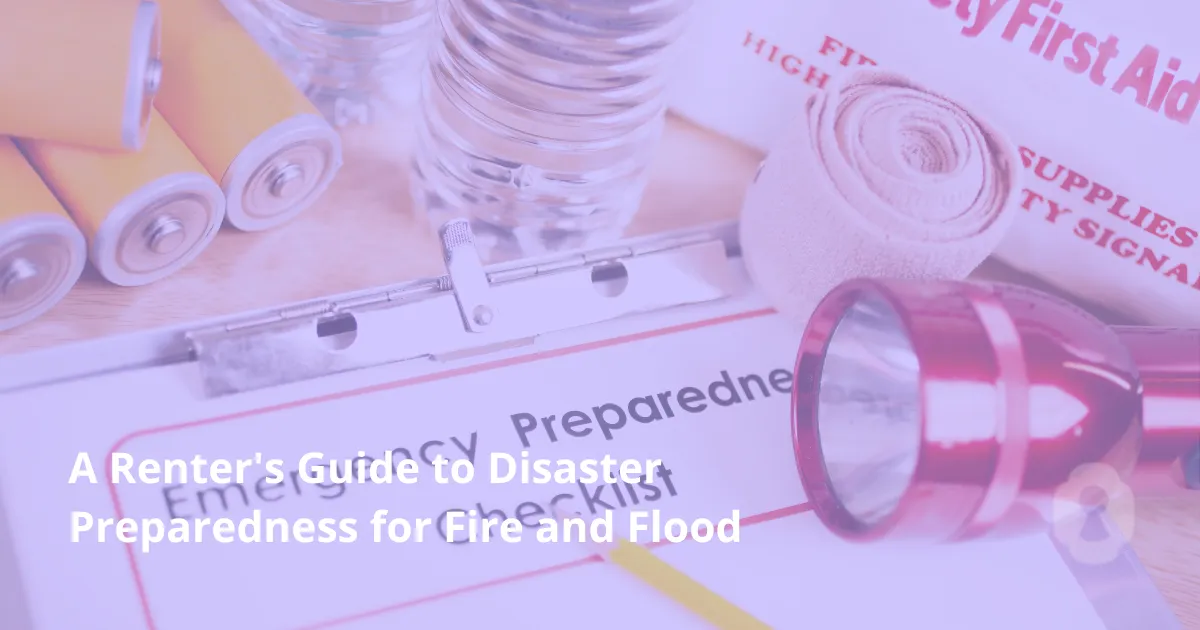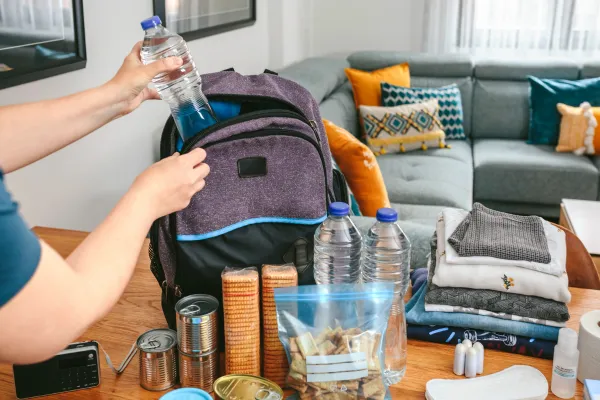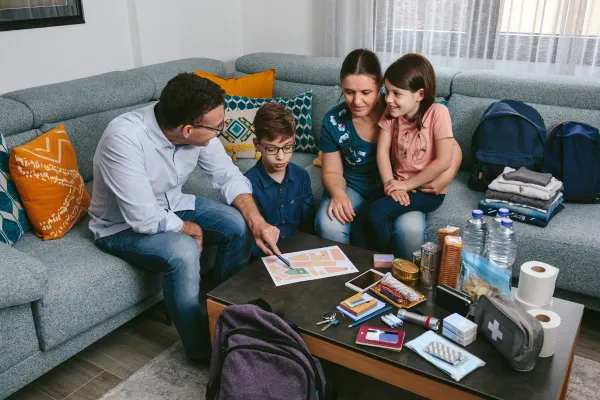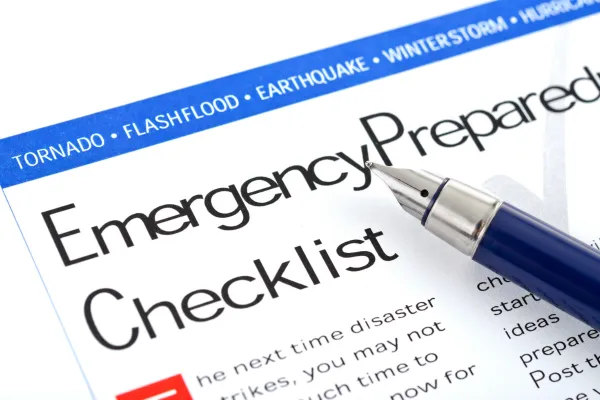
Imagine coming home to find your apartment flooded or filled with smoke. It's a stressful situation that can happen to anyone. As a renter, having a plan in place can make all the difference in staying safe.

Developing an emergency plan is crucial to prepare for unexpected events like natural disasters. By being proactive, you can minimize risks and ensure your safety.
Understanding the risks and taking steps to mitigate them is key. In this article, we'll explore what you can do to prepare for fires and floods.
"What often gets overlooked in emergency preparedness discussions is that renters aren't just protecting their possessions—they're safeguarding their housing stability itself. When disaster strikes, homeowners with insurance can rebuild on their property, but renters face the double vulnerability of potential displacement and competing with others for limited alternative housing. This is why emergency planning for renters must extend beyond the immediate crisis to include longer-term contingencies: where you'll stay if your building becomes uninhabitable, how you'll navigate lease obligations during displacement, and maintaining digital proof of your pre-disaster rental conditions. The most resilient renters understand that preparedness isn't just about surviving the emergency—it's about preserving their housing security in its aftermath."
Taylor Wilson, CEO of Rent with Clara
Being prepared means understanding the types of disasters that could affect your area and taking action before they happen. Homeowners and renters alike need solid preparedness measures, but renters face unique constraints—you can't install permanent fixtures without approval, and you're often dependent on property managers for building-wide safety systems.
The good news? You have full control over your personal emergency preparedness plan, including what goes in your preparedness kit and how you respond when disaster strikes. Start by identifying the specific risks in your region, whether that's an area susceptible to wildfires, hurricane zones, or flood-prone neighborhoods.
Renters deal with challenges that homeowners don't face. You can't modify your unit's structure, install additional carbon monoxide detectors without permission, or make permanent changes to improve safety and well-being.
During emergency scenarios, you might face displacement with limited financial cushion, and you're counting on your landlord to maintain critical systems. But here's what you can control: your personal preparedness, your preparedness kit, knowing your building's layout, and having a solid exit strategy whether you need to evacuate or shelter-in-place.
It's key for renters to take steps to prepare for emergencies.
Your landlord handles building-wide maintenance and inspections, ensures fire suppression systems work, maintains smoke and carbon monoxide detectors in common areas, and provides emergency contact information. Your job? Keep your appliance cords in good condition, don't block exits, report maintenance issues immediately, and create an emergency plan for your household.
Understanding this division prevents confusion when disaster hits. If you're in a high-rise, know that your landlord should have evacuation procedures posted, but you need to actually read them and practice your escape route.
By grasping these duties, renters can prepare better for emergencies. They can also work well with landlords to keep living spaces safe.

Every renter needs a comprehensive plan that addresses potential emergencies specific to their situation. This isn't about creating a complicated document—it's about knowing exactly what to do when you smell smoke, hear tornado sirens, or receive wireless emergency alerts on your phone.
Your plan should include escape routes, safe meeting points, communication protocols, and critical contacts including local emergency management. The Federal Emergency Management Agency recommends that you make a plan, practice it, and update it whenever your living situation changes.
Walk through your building and identify at least two exit routes from your unit. Check stairwells (never plan to use elevators in a fire), note where emergency exits lead, and time how long it takes to get out. If you're in a high-rise, you need to know every stairwell location and which floors have exits to the outside.
Some emergency scenarios require immediate evacuation, while others need you to shelter-in-place—know which emergencies call for which response. Factor in mobility issues, pets, and any obstacles that might slow you down.
Make a note of the nearest exits and practice your route. This ensures you exit quickly and safely.
Pick a contact person outside your immediate area—someone who won't be affected by the same disaster. Everyone in your household should have this person's number memorized.
Designate safe meeting points both near your building (for quick evacuations) and outside your neighborhood (for major disasters). During severe weather or other crises, phone lines get jammed, so having predetermined meetup spots prevents panic.
Share your plan with family members who don't live with you, so they know where you'll go in the event of an emergency.
Ask your property manager about their emergency response protocols and how they'll communicate during a crisis. Find out if they use text alerts, email, or posted notices.
Get clarity on what preparedness measures are already in place—are there generators for a power outage? Is the building equipped for disaster preparedness?
If you're in an area susceptible to wildfires, what's the evacuation protocol? Keep their emergency contact number in your phone and written down in your preparedness kit. Good landlords appreciate tenants who ask these questions.
Visit this resource to learn more about getting prepared for emergencies.

Your preparedness kit should fit your space constraints but contain everything you'd need to survive independently for at least 72 hours. This means water (one gallon per person per day), non-perishable food, a manual can opener, flashlight, batteries, battery-powered radio for wireless emergency alerts, first aid supplies, and any prescription medications.
Store your kit in an easily accessible spot—not buried in a closet you'd struggle to reach in the dark during a power outage. Update it twice a year, checking expiration dates and replacing batteries.
Include bandages in various sizes, antiseptic wipes, pain relievers, antihistamines, any prescription medications, and essential medical equipment. Add a manual can opener, flashlight with extra batteries, and a battery-powered or hand-crank radio to receive updates during an outage.
If you live in an area susceptible to wildfires, include N95 masks to filter smoke. For tornado country, add sturdy shoes and a whistle. Your preparedness kit should also include copies of important documents sealed in waterproof bags—more on that next.
Protect yourself from compounding damage to your home with lost paperwork by digitally scanning your lease, insurance policies, ID, medical records, and storing them securely online. Keep physical copies in a waterproof, fireproof container inside your preparedness kit.
Include a printed list of emergency contacts: your landlord, local emergency management, insurance provider, utility companies, and the Federal Emergency Management Agency (FEMA) hotline. If disaster strikes and you lose your phone, you'll still have access to critical numbers.
Key documents to protect:
By preparing these essential supplies and having a plan, you can lessen the impact of emergencies. This is important for renters.
Fire moves fast—you typically have less than three minutes to escape a burning apartment. Your safety and well-being depend on having working smoke alarms, knowing your escape routes, and practicing what to do.
Conducting drills might feel awkward, but it builds muscle memory for when panic sets in. Know where fire extinguishers are located in your building, but remember: your priority is getting out, not fighting the fire.
Never go back inside for belongings or pets—firefighters are trained for rescue operations.
Smoke and carbon monoxide detectors save lives by giving you early warning before deadly gases accumulate. Test them monthly by pressing the test button—if you can't reach it, ask your landlord to install it lower or provide a step stool.
Replace batteries annually or immediately when they start chirping. Never disable a detector because of cooking smoke; instead, improve ventilation or move it slightly further from the kitchen.
Some newer models connect to wireless emergency alerts systems. If your unit lacks working detectors, that's a serious code violation—report it immediately to local emergency management or your city's housing authority.
Key actions to ensure smoke detector effectiveness:
When fire breaks out, stay calm and execute your comprehensive plan. Alert everyone in your unit immediately, feel doors before opening them (if they're hot, use your alternate route), stay low where the air is clearer, and move quickly to your nearest exit.
Never use elevators—they can trap you or open onto fire floors. If you're in a high-rise, use stairwells and count doors as you descend in case smoke obscures visibility.
Once outside, move to your predetermined safe meeting points and call 911. Account for everyone and tell firefighters if anyone's missing. Never re-enter the building for any reason.
Stay calm and follow these steps:
Small fires in pans or appliances can sometimes be controlled with a fire extinguisher, but only if the fire is contained and you have a clear escape route behind you.
Use the PASS method: Pull the pin, Aim at the base of the flames (not the smoke), Squeeze the handle, and Sweep side to side. If the fire doesn't go out immediately or grows larger, abandon the attempt and evacuate.
Know that your landlord is responsible for providing and maintaining fire extinguishers in common areas, but having one in your unit adds extra protection. Remember: your life matters more than any appliance or belonging.
Flooding causes billions in damage to your home and belongings annually, yet many renters don't realize that standard renters insurance doesn't cover flood damage—you need separate flood insurance. Watch for warning signs like rapidly rising water, unusual rain patterns, or alerts from local emergency management.
If you're in a flood-prone area, prepare by elevating valuables, knowing your evacuation routes, and understanding whether your building's protocol calls for evacuation or shelter-in-place orders. Flash floods can develop in minutes, especially in urban areas where concrete prevents water absorption.
Recognize the signs: heavy or prolonged rain, severe weather warnings, rising creeks or rivers, or alerts from local emergency management. Modern wireless emergency alerts will notify you of flash flood warnings directly on your phone—never ignore them.
If you live near water or in a flood zone, consider flood insurance since standard renters policies won't cover water damage from flooding. Prepare by identifying safe meeting points on higher ground, knowing multiple evacuation routes, and keeping important documents in waterproof containers at the top of your closet or in your preparedness kit.
Before flooding occurs, elevate electronics, important documents, and irreplaceable items to higher shelves or upper levels. Move furniture away from exterior walls if possible.
Unplug appliances to prevent electrical fires when power returns after an outage. If you have advance warning, fill bathtubs and containers with clean water in case supplies become contaminated.
During active flooding, turn off electricity at the breaker if you can do so safely—water and electricity create deadly situations. Take photos of any damage to your home and belongings before cleaning up; you'll need this documentation for insurance claims and potential disaster assistance from the Federal Emergency Management Agency.
When evacuation orders come through wireless emergency alerts or local authorities, leave immediately—don't wait to see how bad it gets. Just six inches of moving water can knock you down, and a foot of water can carry away vehicles.
Never walk, wade, or drive through floodwater; it may be deeper than it looks and can hide hazards like open manholes or downed power lines. Head to your predetermined safe meeting points on higher ground.
If you're trapped by rising water, move to the highest level of your building (not the basement). If you're in a high-rise, move up, not down. Call for help and wait for emergency responders rather than attempting to wade through contaminated floodwater.
Recovery from any disaster starts with having the right insurance coverage before trouble hits. Standard renters insurance protects your belongings from fire, theft, and some types of disasters, but it won't cover flooding or earthquake damage to your home and possessions—those require separate policies.
After a disaster, you'll face immediate expenses like hotel stays, restaurant meals, and replacing essentials. Good insurance covers these costs while you're displaced. Document everything: take photos, save receipts, and file claims promptly to speed up recovery.
Renters insurance typically covers personal property damage from fire, tornado, hurricane, theft, and vandalism. It provides liability coverage if someone's injured in your unit and covers additional living expenses if you can't stay there.
What it doesn't cover: flood insurance requires a separate policy through the National Flood Insurance Program, and earthquake coverage is an additional rider. Review your policy to understand coverage limits—many standard policies cap personal property at $30,000-$50,000, which might not replace everything.
Consider how much your belongings are actually worth and adjust coverage accordingly. If you live in severe weather zones or areas prone to wildfires, make sure your policy covers evacuation expenses and temporary housing.
Key Components of Renters Insurance:
For more detailed information on renters insurance and how it can protect you against disasters, visit https://www.ladrc.org/insurance-for-disasters/.
Before touching anything, photograph or video all damage to your home and belongings from every angle. Create a detailed list of damaged items with their approximate age and value—receipts help but aren't required for most claims.
Save receipts for any temporary expenses like hotel rooms, meals, clothing replacements, or appliance purchases you need immediately. Contact your insurance provider within 24 hours to report the damage and start the claims process.
Don't throw away damaged items until the adjuster says you can. If you need help navigating the recovery process, contact local emergency management or the Federal Emergency Management Agency for disaster assistance programs. Many renters are eligible for aid even if they don't have insurance.
Steps to Filing a Claim:
By understanding your renters insurance and knowing how to document damage and file claims, you can protect your interests. This way, you can recover more quickly from disasters.
As a renter, being ready for emergencies is key to staying strong during disasters. With many subsidized units at risk, emergency prep is a must for everyone. Over 6 million rental units face high risks from climate events each year.
By knowing the risks and acting early, renters can lessen the damage from emergencies. Making an emergency plan, having the right supplies, and staying updated with emergency alerts are essential steps. The COVID-19 pandemic shows how vital it is to be ready for surprises.
By being proactive in emergency prep, renters can boost their resilience. This not only keeps them safe but also helps the whole community stay strong.